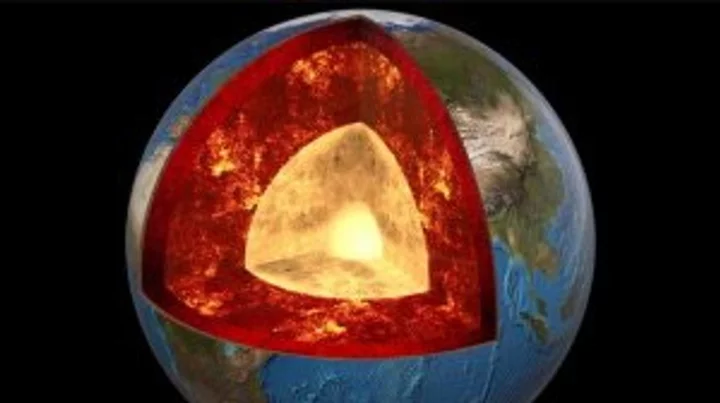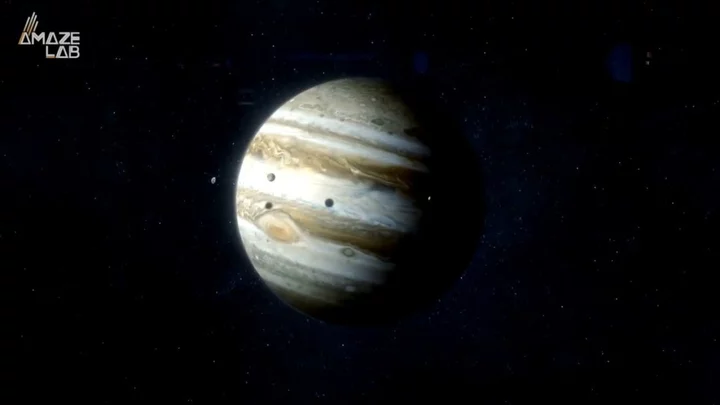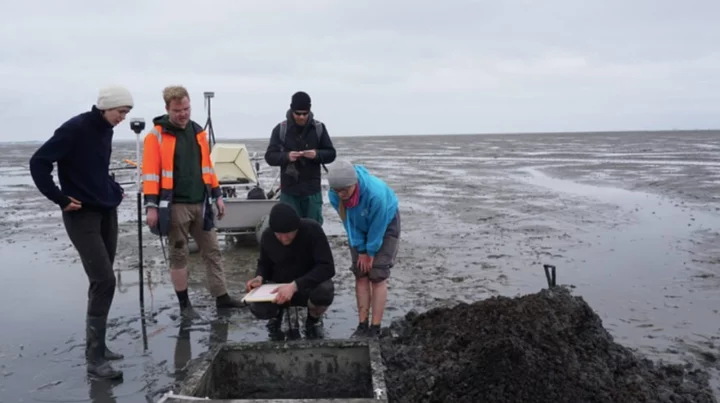
Massive ocean discovered beneath the Earth's crust containing more water than on the surface
It feels like there have been staggering science stories emerging every other day recently, all of which have blown our tiny little minds. First, there was the discovery of a terrifying black hole pointing right at us, then there was a huge hole found in the sun and a missing continent found after going missing for 375 years. Now, people are only just realising that there’s a massive ocean hidden under the Earth’s crust. It turns out there’s a huge supply of water 400 miles underground stored in rock known as 'ringwoodite'. Sign up to our new free Indy100 weekly newsletter Scientists previously discovered that water is stored inside mantle rock in a sponge-like state, which isn’t a liquid, solid or a gas, but instead a fourth state. The scientific paper titled ‘Dehydration melting at the top of the lower mantle’ was published in 2014 and laid out the findings. "The ringwoodite is like a sponge, soaking up water, there is something very special about the crystal structure of ringwoodite that allows it to attract hydrogen and trap water," said geophysicist Steve Jacobsen at the time. "This mineral can contain a lot of water under conditions of the deep mantle,” added Jacobsen, who was part of the team behind the discovery. He added: "I think we are finally seeing evidence for a whole-Earth water cycle, which may help explain the vast amount of liquid water on the surface of our habitable planet. Scientists have been looking for this missing deep water for decades." Scientists made the findings at the time after studying earthquakes and discovering that seismometers were picking up shockwaves under the surface of the Earth. From that, they were able to establish that the water was being held in the rock known as ringwoodite. If the rock contained just 1 per cent water, it would mean that there is three times more water under the surface of the Earth than there is in the oceans on the surface. Have your say in our news democracy. Click the upvote icon at the top of the page to help raise this article through the indy100 rankings.
2023-06-12 15:28

Ancient formation discovered wrapped around Earth's core
The structure of the Earth beneath our feet has been fascinating to members of the scientific community recently, and it turns out it’s far more complex than people initially thought. First, we learned of the news that there’s a massive ocean beneath the Earth’s crust which contains more water than all of the seas on the surface. Now, another study has been published which has taken an in-depth look at the geology beneath the southern hemisphere. The new research, published in Science Advances, has found evidence that an entire ocean floor actually runs the length around the core. Sign up to our new free Indy100 weekly newsletter This is a relatively thin layer that sits on the core-mantle boundary around 1,800 miles beneath the surface of the Earth. It's an ancient formation that could provide more insight into the structure of the planet beneath our feet. Geologist Samantha Hansen and her colleagues from the University of Alabama led the research. They observed the structure by using 15 monitoring stations under the ice of Antarctica, mapping the waves from earthquakes. Doing this allowed them to analyse the structure of the Earth below the surface, including the ultra-low velocity zones where waves moved much slower. "Seismic investigations, such as ours, provide the highest resolution imaging of the interior structure of our planet, and we are finding that this structure is vastly more complicated than once thought," Hansen said. "Analyzing [thousands] of seismic recordings from Antarctica, our high-definition imaging method found thin anomalous zones of material at the CMB everywhere we probed," geophysicist Edward Garnero from Arizona State University also said. "The material's thickness varies from a few kilometers to [tens] of kilometers. This suggests we are seeing mountains on the core, in some places up to five times taller than Mt. Everest." "Our research provides important connections between shallow and deep Earth structure and the overall processes driving our planet," Hansen added. Have your say in our news democracy. Click the upvote icon at the top of the page to help raise this article through the indy100 rankings.
2023-06-12 15:21

Smoky Air Returning to NYC, US Northeast After a Brief Reprieve
Smoke from the worst wildfires in Canadian history returned to New York City and the Northeast on Saturday
2023-06-11 05:27

NY Skies Start Clearing as Rain in Sight: Smoky Air Latest
The skies in the eastern US are starting to become clearer, after smoke from the worst wildfires in
2023-06-09 20:23

White House Delays Pride Event; DC on Alert: Smoky Air Latest
A blanket of heavily polluted air covering much of the eastern US is likely to last until Tuesday,
2023-06-09 01:45

Yankees, Phillies Games Postponed; Flight Delays: Smoke Latest
New York Mayor Eric Adams told residents they should stay inside or wear masks outdoors to battle the
2023-06-08 11:19

Kathleen Folbigg: Woman jailed over infant deaths pardoned
A recent inquiry heard fresh evidence that Kathleen Folbigg did not kill her four children.
2023-06-05 10:52

Scientists baffled by discovery of '2000-year-old computer'
Scientists have been left baffled by the discovery of the wreck of a 2,000-year-old “computer” that is amazingly complex. The Antikythera mechanism – an astronomical calendar – has been dubbed “‘the first computer” and has baffled scientists for generations after it was first discovered inside a Greek shipwreck in 1901. The device is a hand-powered time-keeping instrument that used a wing-up system to track the sun, moon and planets’ celestial time. It also worked as a calendar, tracking the phases of the Moon and the timing of eclipses. Despite sounding relatively simple, the mechanism was actually ahead of its time, being more technically sophisticated than any other tool that was invented over the next 1,000 years. In its current condition, the mechanism is in 82 separate fragments with only a third of its original structure remaining, including 30 corroded bronze gearwheels. Sign up to our free Indy100 weekly newsletter Research into the device from experts at University College London involved 3D computer modelling and helped them solve the mystery of how the device worked, revealing a “creation of genius”. Adam Wojcik, a materials scientist at UCL said at the time: “We believe that our reconstruction fits all the evidence that scientists have gleaned from the extant remains to date.” They theorised that the device tracked the movement of the sun, moon and planets on concentric rings, as the ancient Greeks believed that the sun and planets revolved around Earth, rather than the sun. The researchers explained in Scientific Reports: “Solving this complex 3D puzzle reveals a creation of genius—combining cycles from Babylonian astronomy, mathematics from Plato’s Academy and ancient Greek astronomical theories.” Have your say in our news democracy. Click the upvote icon at the top of the page to help raise this article through the indy100 rankings.
2023-06-02 19:16

Scientists make 'shocking' discovery on Saturn's moon that could reveal signs of life
Dramatic explosions on the surface of one of Saturn's moons have been observed, and it could change the way scientists approach the search for life in the universe. Saturn's ice-covered moon Enceladus has been the subject of attention from astronomers for decades after plumes of water vapor were observed erupting from its surface 20 years ago by the Cassini spacecraft. Now, the biggest plume yet has been spotted by the James Webb Space Telescope and it measures a massive 10,000 kilometers in length. Incredibly, the plume emitting from the geyser on the surface measures 20 times the size of the moon itself, and it indicates that there’s more to Enceladus than previously thought. Sign up to our free Indy100 weekly newsletter Planetary scientist Geronimo Villanueva of NASA's Goddard Space Flight Center said: "When I was looking at the data, at first, I was thinking I had to be wrong, it was just so shocking to map a plume more than 20 times the diameter of the moon. "The plume extends far beyond what we could have imagined." Instead of solid ice, the size of the plume shows us that there’s a liquid ocean under the surface. It’s kept warm enough to avoid freezing due to the movement that results from the gravitational pull of Saturn. As ever, the existence of liquid water suggests that there’s the possibility of life existing there, and it's encouraging news for authors of the study accepted in Nature Astronomy. "The orbit of Enceladus around Saturn is relatively quick, just 33 hours. As it whips around Saturn, the moon and its jets are basically spitting off water, leaving a halo, almost like a donut, in its wake," Villanueva said. "In the Webb observations, not only was the plume huge, but there was just water absolutely everywhere." It remains one of the most interesting bodies being studied in the solar system, as geochemist Christopher Glein of the Southwest Research Institute. “Enceladus is one of the most dynamic objects in the Solar System and is a prime target in humanity's search for life beyond Earth," geochemist Christopher Glein of the Southwest Research Institute said. "In the years since NASA's Cassini spacecraft first looked at Enceladus, we never cease to be amazed by what we find is happening on this extraordinary moon." Have your say in our news democracy. Click the upvote icon at the top of the page to help raise this article through the indy100 rankings.
2023-06-01 22:26

A 'City of Atlantis' has been discovered after being lost for 600 years
The remains of a church from a sunken town known as the 'Atlantis of the North Sea' has been discovered beneath the mud on Germany's coast. The church is believed to be part of a site called 'Rungholt' located in the Wadden Sea. The town, which was previously thought to be a local legend, has not been seen since 1362 after it was submerged beneath the waves during an intense storm. However, new research has shown that the town really did exist and that they had built reinforcements around the settlement to protect them from the severe elements. The research was carried out on the area by archeologists from Kiel University, Johannes Gutenberg University Mainz, the Center for Baltic and Scandinavian Archaeology, and the State Archaeology Department Schleswig-Holstein. Sign up to our free Indy100 weekly newsletter Searching the Wadden Sea which is the longest stretch of intertidal sand and mud flats on Earth, the team, using geophysical imaging technology found man-made mounds that had been constructed to protect the town against the tides. Amongst this structure were the foundations of a building which the team determined had to be a church which may have been the location of the town centre. In a statement, Dr. Dennis Wilken, a geophysicist at Kiel University of Kiel University said: "Settlement remains hidden under the mudflats are first localized and mapped over a wide area using various geophysical methods such as magnetic gradiometry, electromagnetic induction, and seismics." Dr. Hanna Hadler from the Institute of Geography at Mainz University added: "Based on this prospection, we selectively take sediment cores that not only allow us to make statements about spatial and temporal relationships of settlement structures, but also about landscape development." Dr. Ruth Blankenfeldt, an archaeologist at ZBSA also suggested that the "special feature of the find lies in the significance of the church as the centre of a settlement structure, which in its size must be interpreted as a parish with superordinate function." The storm that washed away Rungholt has gone down in history as one of the largest to ever hit the region, affecting not just Germany but also the Netherlands, Denmark and the UK. The storm happened on January 1362 and has since been referred to as "the great drowning of men." According to historical reports, Rungholt was once a busy trading port for fishermen but was also populated by taverns, brothels and churches. Have your say in our news democracy. Click the upvote icon at the top of the page to help raise this article through the indy100 rankings.
2023-05-31 17:21

Biden-McCarthy Debt Limit Deal Puts Government Services on a Diet
The debt-limit deal would rein in spending on some federal government services but barely dents the roughly $20
2023-05-31 09:51

11 Myths About Ticks, Debunked
Before venturing outdoors, read up on the most common myths about ticks.
2023-05-31 00:50
